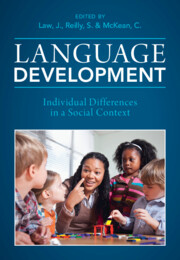Book contents
- Language Development
- Language Development
- Copyright page
- Contents
- Figures
- Tables
- Contributors
- A Tribute to Our Friend, Colleague and Fellow Editor, Professor James Law
- Introduction
- Part One Factors Influencing Language Development
- Part Two Continuity and Change
- Part Three Impact, Intervention and Equity
- 15 Communication, Participation and Cohort Studies
- 16 Capturing the Voice of Parents and Children
- 17 Oral Language Skills as a Foundation for Learning to Learn
- 18 The Economic Impact of Low Language Ability in Childhood
- 19 A Review of Interventions to Promote Language Development in Early Childhood
- 20 Interventions to Promote Language Development in Typical and Atypical Populations
- 21 The Effect of Kindergarten Instructional Policies on Reading and Math Achievement Gaps
- 22 Educational Interventions Targeting Language Development
- 23 Equity and Access to Services for Children with Language Difficulties
- Index
- References
19 - A Review of Interventions to Promote Language Development in Early Childhood
from Part Three - Impact, Intervention and Equity
Published online by Cambridge University Press: 11 August 2022
- Language Development
- Language Development
- Copyright page
- Contents
- Figures
- Tables
- Contributors
- A Tribute to Our Friend, Colleague and Fellow Editor, Professor James Law
- Introduction
- Part One Factors Influencing Language Development
- Part Two Continuity and Change
- Part Three Impact, Intervention and Equity
- 15 Communication, Participation and Cohort Studies
- 16 Capturing the Voice of Parents and Children
- 17 Oral Language Skills as a Foundation for Learning to Learn
- 18 The Economic Impact of Low Language Ability in Childhood
- 19 A Review of Interventions to Promote Language Development in Early Childhood
- 20 Interventions to Promote Language Development in Typical and Atypical Populations
- 21 The Effect of Kindergarten Instructional Policies on Reading and Math Achievement Gaps
- 22 Educational Interventions Targeting Language Development
- 23 Equity and Access to Services for Children with Language Difficulties
- Index
- References
Summary
Disparities in language development emerge in the first year of life and increase with age; consequently, infancy and toddlerhood are key periods whereby early language outcomes may be optimised via prevention and early intervention programs. As yet, the efficacy of programs promoting early language in the first three years of life remains unknown. This chapter provides the reader with findings from a systematic review of interventions aimed at improving child language outcomes for 0–3 year olds. Using a narrative synthesis, we examine and describe the evidence for effective language interventions across the preventive intervention spectrum (universal, selective, indicated/targeted). Specifically, we explore what works for who and under what circumstances. This review provides important insights about early language interventions, including factors contributing to positive outcomes. Findings also suggest how early interventions may be tailored to foster language outcomes for different groups of children (i.e. targeting children at-risk based on low socio-economic status or those with identified language difficulties). This review also highlights the need for further evaluation of promising interventions when applied to the broader population.
Keywords
- Type
- Chapter
- Information
- Language DevelopmentIndividual Differences in a Social Context, pp. 443 - 469Publisher: Cambridge University PressPrint publication year: 2022
References
- 2
- Cited by



